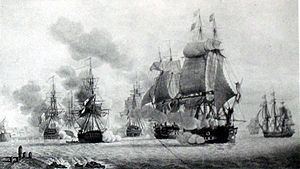Date 23 February 1809 | Result Indecisive | |
 | ||
Similar Raid on Saint‑Paul, Napoleonic Wars, Battle of Radzymin, Battle of the Basque Roads, Invasion of Isle de France | ||
The Battle of Les Sables-d'Olonne was a limited frigate action that took place on 23 February 1809 off Les Sables-d'Olonne. Three ships of the line and two attached ships of the British squadron blockading the harbours of the Atlantic coast engaged a small French frigate squadron comprising Calypso (40), Cybèle (40) and Italienne (40). The French managed to repel the British attack but at the cost of irreparable damage leading to the subsequent decommissioning of the three frigates involved.
Contents
Background
In February 1809, two British squadrons, each counting four ships of the line and several frigates, blockaded Lorient and Île d'Aix. In Lorient they had trapped a strong frigate squadron under captain Amable Troude that comprised the heavy 40-gun frigates Cybèle, Italienne and Calypso.
The French conceived a plan by which a squadron from Brest, under rear Admiral Willaumez, would sail to Lorient. It would then engage the blockading ships and distract them while Troude's squadron would set sail and make its junction with Willaumez' forces.
Willaumez departed Brest on 21 February 1809, leading a squadron of eight ships of the line and two frigates. They arrived off Lorient at nightfall. However, calms prevented the Lorient squadron from weighing anchor and the Brest squadron had left when Cybèle, Italienne and Calypso finally left harbour, under captain de La Gravière. They headed towards Rochefort in the hope of making their junction with Willaumez and Bergeret.
Action
On 23 February, the French frigate squadron arrived near Belle Île. The frigate HMS Amelia (38) and the 18-gun brig-sloop Dotterel spotted the squadron and shadowed it. A few hours later, Calypso spotted five ships and a frigate heading to Lorient. The chase went on all night. The next morning, as the frigates arrived off Tour de la Baleine on the Île de Ré, the British ships were so close that they started manoeuvering to pass the stern of Cybèle. The French then challenged Amelia and Dotterel, which failed to answer their signals, and Italienne hauled up to support Cybèle. La Gravière then decided to seek refuge at Les Sables-d'Olonne, under the protection of coastal defences, before larger British forces could gather.
The French arrived at Les Sables-d'Olonne at 9:15 and made anchor in shallow waters. A quarter of an hour later, the British arrived, Amelia and Dotterel having joined with the Third Rates HMS Caesar (80), HMS Defiance (74) and HMS Donegal (74), under Admiral Robert Stopford. In spite of the shallow waters, Defiance was able to anchor within half a mile of the French frigates, on the right of Italienne, whilst HMS Donegal and HMS Caesar had to anchor further out because of their deeper draughts.
A furious artillery exchange broke out that caused considerable damage to all involved. Italienne and Cybèle had their cables cut and caught fire, while Calypso was beached. Three hours into the fight, Defiance, whose manoeuvers the high reefs had hampered, found herself stranded in an unfavourable position and exposed to French fire for so long that she had to retreat, her stern entirely destroyed. The frigates and coastal forts inflicted lesser damage on Caesar and Donegal. Amelia had her bowsprit shot through and she was holed in several places but had no casualties.
An hour and a half afterwards, descending tides made the waters too shallow for the British ships and they had to break off. Jurien de la Gravière's badly battered squadron then entered the harbour of Les Sables d'Olonne, having lost 64 men killed and 47 wounded.
Aftermath
The battle was presented as a victory on the French side as three 40-gun frigates had survived and fought off an 80-gun and two 74s. The British usually described the action as after "a heavy bombardment the French ships were driven on shore and were subsequently wrecked". The frigates did survive but were in such a battered state that Cybèle was declared irreparable and broken up. The French Navy declared Italienne and Calypso no longer suitable for naval duty and sold them for commerce.
